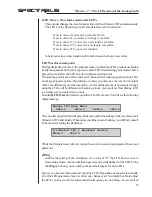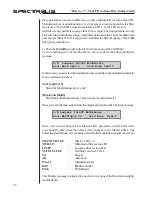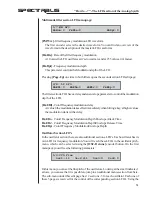
47
SPECTRALIS
For instance you could route an oscillator to the lowpass filter, then route the signal from
there to the multimode-filter and finally send the output signal of the multimode-filter back
to the lowpass. Without fail this will prompt the Spectralis to create a sharp high-pitched
noise. No pain, no gain – especially if you’re not sure at which stage of the routing the
feedback was generated. Still, ”Effect”-sounds especially can benefit from the feedback
and produce beautiful noise! When you consider the possibilities, who would want to
eliminate such features?! We certainly didn’t!
e.)
You’ll be hard-pressed to find a more impressive modulation-matrix. All of the possible
modulation- and signal sources are already connected with the modulation-and signal-
targets.You can determine with an encoder how much you want the respective connection
to affect a parameter. Just imagine a semi-modular system, where VCA’s have taken the
place of cables connecting the individual modules and you will have a pretty good idea
what the Spectralis has to offer.
What’s the purpose of such totally flexible routing? For one, while you can’t get around
establishing all of the connections with cables in a modulation-matrix, all of the possible
connections are already set up in the Spectralis. This allows very dynamic control over
the sounds. It basically enables you to cross-fade between different routings.
3.3.2 Let's go - Getting familiar with the analog filters.
Enough with the preamble. I’m sure you’re dieing to finally hear the synthesizer by now.
As with all the examples in the "How to...?"-section, we will be assuming that you have
already connected a MIDI-Keyboard to your Spectralis and have it set to send on MIDI-
channel 1. Now push the Part->
[Select]
-button and select part 12
[Analog Synth]
.
For this example we are also going from the assumption that the original factory presets
are still present in your Spectralis.
Next select the
[Song]
-button in the "Num-Button-Assignment"-section and chose song
6 with Numeric button
[6]
. Also in the "Num-Button-Assignment"-section now push the
[Pattern]
-Button and last the numeric button
[1]
. Playing a key on your MIDI-Keyboard
you should now be hearing a pretty fat synth-bass sound. This sound uses the 24dB
lowpass filter. The filter-frequency is being controlled via the envelope of the 24dB lowpass
filter.
You can now turn the
(CutOff LP)
-encoder while playing your keyboard. You should
hear some definite sound changes. If you are turning the encoder to the right the sound
should become brighter and more sparkling, turning the encoder to the left should make
the sound darker and duller. You will notice however that turning the encoder further to
the left is not closing the filter fully. Don’t be alarmed. This results from the fact, that the
filter is being controlled by the encoder, however the resulting control voltage is being
added to the control voltages of the other modulators.
As mentioned earlier, the cutoff-frequency of the sound is being controlled by the envelope.
Obviously in this case the ”sustain-level” of the controlling envelope is opened to a point,
where the filter won’t close completely.
This means of course, if you were to change the amount of the envelope-dependency it
should be possible to close the filter further??! We’ll give it a try! If you have paid close
attention during the earlier chapters of this manual you will remember how to access a
parameter. Just use the
(CutOff LP)
-button to access the parameter pages, which allow
"How to...?": Playing the "Analog"-synthesizer
Summary of Contents for Spectralis
Page 1: ...1 SPECTRALIS Spectralis...








































